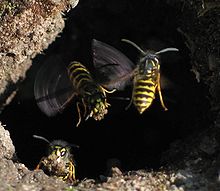Aculeata
| Aculeata Temporal range:
| |
|---|---|

| |
| Vespula vulgaris | |
| Scientific classification | |
| Domain: | Eukaryota |
| Kingdom: | Animalia |
| Phylum: | Arthropoda |
| Class: | Insecta |
| Order: | Hymenoptera |
| Suborder: | Apocrita |
| Infraorder: | Aculeata (but see text) |
| Superfamilies | |
| |
Aculeata is a
parasitic
.
This group includes all of the
Hymenopterans. It is theorized that the possession of a venomous sting was important in the repeated evolution of eusociality
within Hymenoptera.
The oldest aculeates are known from the Late Jurassic Karabastau Formation of Kazakhstan, represented by the family Bethylonymidae, which may be para or polyphyletic.[1]
Classification
The use of the name Aculeata has a long history at the rank of
infraorder or division. The Aculeata are a monophyletic, or good natural group, containing all the descendants of a single common ancestor. The Aculeata are therefore maintained as a taxon, either at infraorder or division rank or as an unranked clade.[2][3][4][5][6]
| Hymenoptera |
| ||||||||||||||||||||||||||||||||||||||||||||||||||||||||||||||||||
References
- PMID 31728419.
- PMID 24094856.
- PMID 28376325.
- .
- ^ Schulmeister, S. "Symphyta". Archived from the original on 21 June 2010. Retrieved 28 November 2016.
- PMID 28343967.
External links
- Tree of Life Web Project: Aculeata
- [1] Bugguide.net: Aculeata
- Johnson, B. et al. Phylogenomics resolves evolutionary relationships among ants, bees, and wasps. NCBI

